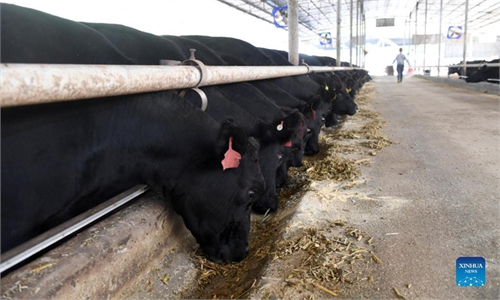Brazilian beef exports to China suspended after mad cow disease; Australian supply may be boosted

Imported beef is sold in a supermarket in Shanghai. Photo: VCG
Brazil, the largest beef exporter to China, has announced the suspension of beef exports to China, its major destination market, starting on Thursday after confirming a case of mad cow disease, to prevent the risks of a spread of the animal illness.
Given that Brazilian beef takes the top share in the Chinese market, the halt may push up the domestic market prices while supporting supplies of other exporting countries including Australia. The latter is seeing a potential resumption trend amid a trade recovery, industry analysts said.
The case of bovine spongiform encephalopathy was confirmed by Brazil's Agriculture Ministry on Wednesday, and shipments to China were halted as part of a trade protocol between the two nations, Bloomberg reported on Thursday.
Brazilian authorities will hold conversations with their Chinese counterparts in a bid for a "prompt re-establishment" of trade flows, the ministry said in a statement.
While the Brazilian government has yet to disclose the exact time of the trade resumption, media and analysts believe that the suspension would be temporary and therefore the potential market impact, mostly on prices, is controllable.
The halt of Brazilian beef exports to China will lead to an increase in domestic spot quotations in a short period of time, Tony Zeng, co-founder of Rui Sheng Da Consulting, told the Global Times on Thursday, noting that after the news came out, some spot traders re-evaluated the market price.
"The unit price of some beef-related products has increased by more than 10,000 yuan ($1,450)," Zeng said.
China imported a total of 2.688 million tons of beef in 2022, of which 1.105 million tons were from Brazil, accounting for 41 percent of the total and making it China's largest foreign beef source, according to the General Administration of Customs of China.
Despite the high proportion, given that the beef supply in the domestic market is still in the destocking stage, the impact from the Brazilian beef export halt would be temporary and can be alleviated via alternative options and diversified supplies, industry insiders said.
On the one hand, beef supply can be flexible, since other types of meat such as pork and lamb are also very popular in the Chinese market; moreover, China imports beef from more than 25 countries.
Besides of Brazil, countries such as Argentina, Uruguay and New Zealand are also supplying a big share, and there is a trend of further growth driven by demand.
An employee of the China Cattle Industry Association surnamed Zhao told the Global Times on Thursday that Brazilian beef, which represents about 40 percent of China's total beef imports, may lead to a certain expansion of beef imports from countries including Australia.
Australian beef exports, which ran into hurdles amid soured China-Australia relations, are expected to recover as companies are gradually regaining confidence in Australian supplies, industry insiders said.
In 2022, Australian beef exports to the Chinese mainland dropped 2 percent year-on-year to 175,127 tons, according to Meat & Livestock Australia. Still, Australia has been one of the major suppliers of beef to China, despite the decrease.
"After the export halt of Brazilian beef, Australian beef exports may see some rebound," Zhao said, noting that this can be a process of "ebb and flow."
Due to the high proportion of Brazil's exports in China, the absence will increase the overall market prices of imported beef, and it will also stimulate a wave of import demand and a turn to new markets, Zeng said.
But the expert had reservations in terms of how much it will boost Australian beef imports, given the differences in downstream consumption between South American beef and Australian beef in terms of catering.
For example, Australian beef is mostly used in mid- to high-end catering, while some parts of South American beef are used in factories to develop sauced pork and beef jerky, Zeng said.
China's home beef production is also expanding in response to domestic demand. In 2022, China's domestic beef supply accounted for 73 percent of its overall beef consumption. The self-sufficiency rate of beef is expected to reach 85 percent in the 14th Five-Year Plan period (2021-25).


